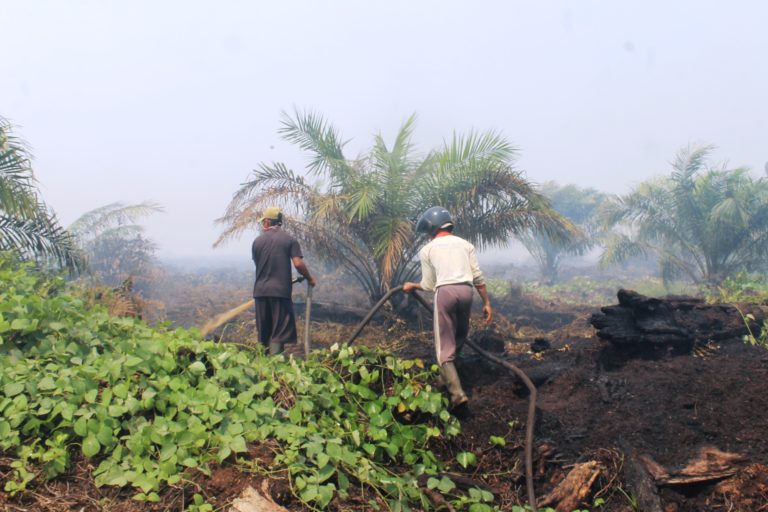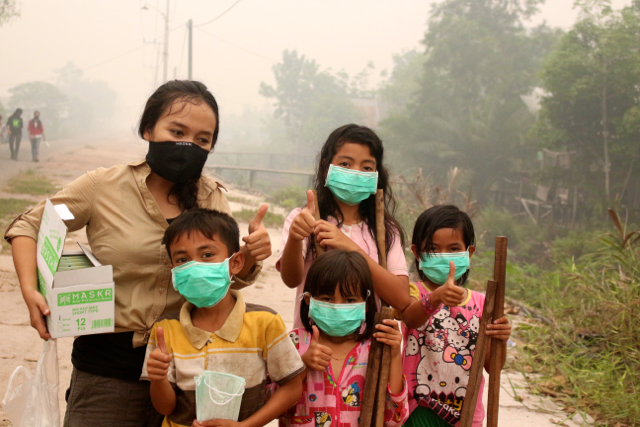- Indonesia’s environment minister continues to deny that fires in the country are sending toxic haze to neighboring Malaysia and Singapore.
- An environmental activist warns that this stance, which goes against the data presented by Malaysia, risks undermining Indonesia’s credibility.
- The haze is an annual irritant in diplomatic ties between Indonesia and its neighbors, with much of the burning taking place to clear land for oil palm and pulpwood plantations.
- Malaysia has offered to help Indonesia fight the fires, which have sickened tens of thousands of people in Sumatra and Borneo, threatened an elephant reserve, and churned more than 100 millions of tons of carbon dioxide into the atmosphere.
JAKARTA — Indonesia’s environment minister risks undermining the country’s credibility if she continues denying, in the face of overwhelming data, that haze from Indonesian forest fires is affecting neighboring Malaysia and Singapore, an activist says.
Siti Nurbaya Bakar, the minister of environment and forestry, said on Sept. 11 that she would write to her Malaysian counterpart, Yeo Bee Yin, via the Malaysian ambassador, to address the problem “objectively.”
“Because the fact is that the smoke entering Malaysia, into Kuala Lumpur, comes from Sarawak [in Malaysian Borneo] and also from the Malay Peninsula, and maybe also partly from West Kalimantan [in Indonesian Borneo],” she said as reported by Tempo.
Yeo, however, said the facts showed otherwise.
“Let the data speak for itself,” she wrote in a Facebook post.
She then went on to cite figures from the Association of Southeast Asian Nations’ (ASEAN) Specialist Meteorological Centre, the ASMC, showing a massive disparity between the number of fire hotspots in Indonesia and Malaysia.

On Sept. 10, there were 474 fires in Indonesian Borneo, also known as Kalimantan, and 387 in Sumatra. That same day, there were only seven hotspots detected in Malaysia: four in Malaysian Borneo and three in Peninsular Malaysia.
On Sept. 11, the number of hotspots had spiked to 1,188 in Kalimantan and 431 in Sumatra, and gone down to just five in Malaysia.
“As for [Siti’s] claim that the haze is from Sarawak, just look at the wind direction,” Yeo wrote. “How is it logically possible?
“Minister Siti Nurbaya should not be in denial,” she added.

In a separate statement, Yeo said “The data clearly shows that the haze is from Indonesia,” and added that she had discussed the matter with the Malaysian prime minister, who agreed to write to Indonesia’s president about the transboundary haze.
Singapore has also attributed the haze in the city-state to the fires in Sumatra, with the National Environment Agency (NEA) warning that air quality would enter the “unhealthy” range if the fires persisted.
Siti again denied that the Indonesian fires were to blame. “That’s not true that there’s [haze] from Riau [province] crossing to Singapore,” she said. “Why? Because in Riau [the number of hotspots] has declined.”

‘She will be embarrassed’
Siti’s insistence that the haze affecting neighboring countries isn’t coming from Indonesia could end in embarrassment for the Indonesian minister, said Kiki Taufik, Greenpeace Southeast Asia’s Indonesian forest campaign head.
“If the minister keeps debating by saying there’s no [transboundary haze], she will be embarrassed when she is shown the map that there’s [transboundary haze],” he told Mongabay. “Therefore, it’s better to focus on extinguishing the fires. The problem is the people in Sumatra and Kalimantan who are suffering. So why bother [debating]? Just extinguish the fires.”
Kiki also questioned Siti’s apparent refutation of the ASMC data, which are drawn from the U.S. National Oceanic and Atmospheric Administration (NOAA). He said Malaysia was right to refer to the ASMC, given that the institution was established in 1993 as a collaborative effort by ASEAN member states, which include Indonesia and Malaysia, to monitor and assess land and forest fires as well as transboundary haze in the region. Refuting the ASMC data will only tarnish Indonesia’s reputation, Kiki said.
“The ASMC was established together [by ASEAN members]. So if we don’t believe [the ASMC], our country’s credibility will be laughed at,” he said.
Kiki also noted that Indonesia had ratified the ASEAN Agreement on Transboundary Haze Pollution (AATHP), which came in response to a haze crisis in the region caused by widespread forest fires in Indonesia in 1997 and 1998. The agreement calls on member states to “undertake measures to prevent and control activities related to land and/or forest fires that may lead to transboundary haze pollution.”

‘Situation could worsen’
In its alerts, the ASMC said some haze from West Kalimantan had been blown by winds to western Sarawak, while haze from Riau and Jambi provinces in Sumatra had been blown across the Strait of Malacca to western parts of Peninsular Malaysia.
“The prevailing dry weather in the region is expected to persist in the coming weeks and a further escalation of hotspot activities in Sumatra is possible,” the center said. “With the prevailing winds expected to continue blowing from the southeast or southwest, the transboundary haze situation could worsen.”
Malaysia, in particular, has been heavily affected by the haze, with some parts of the peninsula blanketed in heavily polluted air.
On Sept. 10, the Air Pollutant Index (API) in Kuala Lumpur hit 138, in the “unhealthy” range, the New Straits Times reported. It was the highest API reading in the city since the last haze crisis in 2015, also a result of forest fires raging across the strait in Sumatra.
Malaysian Borneo has also suffered from the ongoing haze episode, with the government having to distribute half a million face masks and shut down 409 schools in the state of Sarawak after the air quality in the state reached “very unhealthy” levels on Sept. 10. Schools were reopened the following day.
Boo Siang Voon, a 47-year-old engineer in Kuching, the capital of Sarawak, described the skies as “hazy, hot with smoky smell.”
“This year the smog is getting worse,” he told AFP. “Residents are using face masks. We should not pay the price of our health for the open burning. We want a solution.”
The air quality in Singapore has also been worsening, but remains within a moderate range for now. The haze from Indonesia has reportedly also reached as far as southern Thailand, with authorities there detecting an increase in dust particles of less than 2.5 microns, known as PM2.5, that can lead to many health problems, including coughing, breathing difficulties and eye irritation.

Offers of assistance
The ASEAN haze agreement encourages member states to help one another fight fires. Greenpeace’s Kiki urged the Indonesian government to accept the repeated offers of assistance made by Malaysia to that end.
The Malaysian ambassador to Indonesia, Zainal Abidin Bakar, said his government had sent a diplomatic note, mistakenly perceived as a protest letter, to the Indonesian government.
“It is not a protest letter, but is of Malaysia’s intention to help in dealing with haze (to fight fire at forest and agricultural areas in Indonesia),” he said as quoted by The Star Online, adding that Malaysia was not pointing a finger at Indonesia over the current haze problem.
“If Malaysia said they could help us, then let’s work together to extinguish the fires,” Kiki said. “Because many owners of palm oil plantations [in Indonesia] are from Singapore and Malaysia. So there’s no need to worry that Indonesia will be perceived as a smog exporter. What’s important is tackling the problem.”
During this year’s fire season, the Indonesian environment ministry’s law enforcement department has sealed off fire-hit concessions held by 30 companies, some of them Singaporean and Malaysian companies. Four of the 30 companies have been charged in connection with the fires.
Universiti Putra Malaysia (UPM) environmental expert Mohd Yusoff Ishak told the New Straits Times that Malaysia and Singapore should form a joint investigation team with Indonesia to crack down on those responsible for the forest fires, especially those in the concessions of big companies.
He added that Malaysia had to be prepared to prosecute its own companies because “we have a large number of Malaysian-run corporations in the affected areas.”
“This time around, it can’t just be small planters that are doing this,” he told the Malaysian newspaper. “I believe that part of this is due to big corporations allowing such incidents. That’s why we need to have a multi-pronged strategy, where we target big companies that allow their plantations to be burnt.”

Carbon emissions
Experts have warned of an exacerbated fire risk this year as a result of an intense dry season and El Niño weather pattern. This year’s fire season is expected to be the worst since 2015, when similar conditions led to the razing of more than 20,000 square kilometers (7,700 square miles) of land, much of it peat forest. The fires each year are set deliberately to clear land for oil palm and pulpwood plantations.
This year, the fires are taking a heavy toll on public health. In South Sumatra province alone, more than 32,000 people have reportedly suffered from respiratory tract infections in the past five weeks. Nearly half are infants under the age of 5.
The fires are also affecting wildlife in Sumatra. Fires have reportedly spread into Padang-Sugihan Wildlife Reserve, in South Sumatra, one of the last strongholds of the Sumatran elephant.
“Last week there were 12 [fire] hotspots, but on Monday we detected more,” Adio Syafri, of the Hutan Kita Institute, an NGO, told Mongabay Indonesia.
Yusuf Bahtimi, a peatland researcher at the Center for International Forestry Research (CIFOR), confirmed the presence of the hotspots, saying they were visible from a village on the periphery of the reserve.
The fires also spell disaster for Indonesia’s commitment to curb its carbon emissions. Nearly 3,400 square kilometers (1,300 square miles) of forest have been burned in the first eight months of the year, according to official figures. That has resulted in the release of almost 110 million tons of carbon dioxide equivalent (CO2e) into the atmosphere — nearly half of Indonesia’s annual emissions between 2006 and 2016.
Ruandha Agung Suhardiman, the environment ministry’s head of climate change, played down the figures, saying that the 2018 fire season saw 5,100 square kilometers (1,970 square miles) of forest razed and 121 million tons of CO2e emitted.
But with this year’s dry season still expected to escalate, peaking in October, the haze and fire episode is expected to only get worse in the coming weeks, with carbon emissions also set to balloon.
Banner image: A military personnel extinguishes fires at Panderman Mountain in East Java, Indonesia, in 2019. Image by Falahi Mubarok/Mongabay Indonesia.
FEEDBACK: Use this form to send a message to the author of this post. If you want to post a public comment, you can do that at the bottom of the page.
